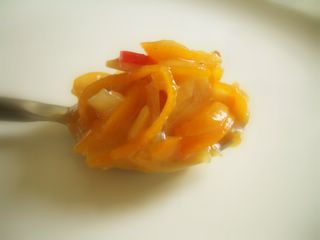Tuesday, May 24, 2005
Kumquat Chutney
.
 Coming to us from China, (via England, of course) the kumquat is a scrumptious little treat, similar to (but botanically NOT) citrus fruit. The whole thing is eaten, since they are so small and not really juicy. The skin is what is sweet, while the interior (what there is of it) is quite tart.
Coming to us from China, (via England, of course) the kumquat is a scrumptious little treat, similar to (but botanically NOT) citrus fruit. The whole thing is eaten, since they are so small and not really juicy. The skin is what is sweet, while the interior (what there is of it) is quite tart.
Lately, in some of your more chic and edgy bars, the kumquat has become a cocktail garnish, which is something I am all for. They are so citrusy and tart they are a good foil for any hard alcohol, but taste especially tantalizing with tequila or sparkling wine. Amazingly satisfying.
Another delicious use for them, and one that is a touch more culinary, is to make kumquat chutney, which is so tangy and delicious I tend to eat it straight, over rice, or like last night, over simply grilled chicken breasts.
This takes a few minutes to make, and can be kept in the fridge for about six weeks, if it lasts that long.
1 tablespoon vegetable oil
2 cloves garlic, sliced thin
1 tablespoon fresh ginger, minced
1 medium onion, sliced thin
2 chiles sliced into rings
1 pint kumquats, rinsed and sliced thin
1 star whole star anise
½ cup sugar
2 teaspoons salt
1 teaspoon fresh ground black pepper
1 tablespoon white vinegar
½ cup orange juice
Saute the garlic, onions, ginger and chiles in the vegetable oil over medium heat, until softened, about 4 minutes.
Add the rest of the ingredients, stir and bring to a simmer. Let cook until kumquats are softened, about 15-20 minutes. Taste and adjust seasonings. Remove from heat and allow to cool. Store in a clean, glass jar. Remove star anise before eating.
Makes about 1 ½ cups. Can be doubled.
______________________________________________________
The well-known ad campaigns for farm products — including "Beef. It's What's for Dinner" and "Got Milk?" — won a reprieve Monday when the Supreme Court ruled that farmers and ranchers could be forced to pay for these government-sponsored promotions.In a 6-3 decision, the Supreme Court rejected a free-speech challenge brought by dissident ranchers who objected to paying for the ads.
The programs began in the 1930s during the Depression, when the government sought to help farmers by increasing demand for their products. In recent decades, lawmakers in Washington and Sacramento have created new marketing programs to advertise and promote farm products. The federal effort includes campaigns for cotton, potatoes, peanuts and eggs. The producers of the goods pay for the ads. Cattle ranchers, for example, are assessed $1 per head of cattle sold, and the money funds the ads promoting beef.
Until Monday, the programs were under steady legal attack by cattlemen and farmers who said they should not be forced by the government to pay for messages they opposed. Some ranchers said their animals were organically fed or ranged freely, and they resented the implicit message of the ads that all beef was the same.
Their lawyers relied on Thomas Jefferson's comment that "to compel a man to furnish contributions of money for the propagation of opinions which he disbelieves is sinful and tyrannical."But the Supreme Court ruled Monday that because the programs were run by the government, they could collect money from those who benefited from them.
The beef promotional program was created by Congress in 1985. The secretary of Agriculture appoints the members of the Beef Board, who in turn create the ads.
The message of the promotional campaigns is effectively controlled by the federal government itself," said Scalia, even though the ads say "Funded by America's Beef Producers." -LA TIMES
Post a Comment
 Coming to us from China, (via England, of course) the kumquat is a scrumptious little treat, similar to (but botanically NOT) citrus fruit. The whole thing is eaten, since they are so small and not really juicy. The skin is what is sweet, while the interior (what there is of it) is quite tart.
Coming to us from China, (via England, of course) the kumquat is a scrumptious little treat, similar to (but botanically NOT) citrus fruit. The whole thing is eaten, since they are so small and not really juicy. The skin is what is sweet, while the interior (what there is of it) is quite tart.Lately, in some of your more chic and edgy bars, the kumquat has become a cocktail garnish, which is something I am all for. They are so citrusy and tart they are a good foil for any hard alcohol, but taste especially tantalizing with tequila or sparkling wine. Amazingly satisfying.
Another delicious use for them, and one that is a touch more culinary, is to make kumquat chutney, which is so tangy and delicious I tend to eat it straight, over rice, or like last night, over simply grilled chicken breasts.
This takes a few minutes to make, and can be kept in the fridge for about six weeks, if it lasts that long.
1 tablespoon vegetable oil
2 cloves garlic, sliced thin
1 tablespoon fresh ginger, minced
1 medium onion, sliced thin
2 chiles sliced into rings
1 pint kumquats, rinsed and sliced thin
1 star whole star anise
½ cup sugar
2 teaspoons salt
1 teaspoon fresh ground black pepper
1 tablespoon white vinegar
½ cup orange juice
Saute the garlic, onions, ginger and chiles in the vegetable oil over medium heat, until softened, about 4 minutes.
Add the rest of the ingredients, stir and bring to a simmer. Let cook until kumquats are softened, about 15-20 minutes. Taste and adjust seasonings. Remove from heat and allow to cool. Store in a clean, glass jar. Remove star anise before eating.
Makes about 1 ½ cups. Can be doubled.
______________________________________________________
The well-known ad campaigns for farm products — including "Beef. It's What's for Dinner" and "Got Milk?" — won a reprieve Monday when the Supreme Court ruled that farmers and ranchers could be forced to pay for these government-sponsored promotions.In a 6-3 decision, the Supreme Court rejected a free-speech challenge brought by dissident ranchers who objected to paying for the ads.
The programs began in the 1930s during the Depression, when the government sought to help farmers by increasing demand for their products. In recent decades, lawmakers in Washington and Sacramento have created new marketing programs to advertise and promote farm products. The federal effort includes campaigns for cotton, potatoes, peanuts and eggs. The producers of the goods pay for the ads. Cattle ranchers, for example, are assessed $1 per head of cattle sold, and the money funds the ads promoting beef.
Until Monday, the programs were under steady legal attack by cattlemen and farmers who said they should not be forced by the government to pay for messages they opposed. Some ranchers said their animals were organically fed or ranged freely, and they resented the implicit message of the ads that all beef was the same.
Their lawyers relied on Thomas Jefferson's comment that "to compel a man to furnish contributions of money for the propagation of opinions which he disbelieves is sinful and tyrannical."But the Supreme Court ruled Monday that because the programs were run by the government, they could collect money from those who benefited from them.
The beef promotional program was created by Congress in 1985. The secretary of Agriculture appoints the members of the Beef Board, who in turn create the ads.
The message of the promotional campaigns is effectively controlled by the federal government itself," said Scalia, even though the ads say "Funded by America's Beef Producers." -LA TIMES
Labels: Condiment, Gluten Free, Vegan
<< Home

